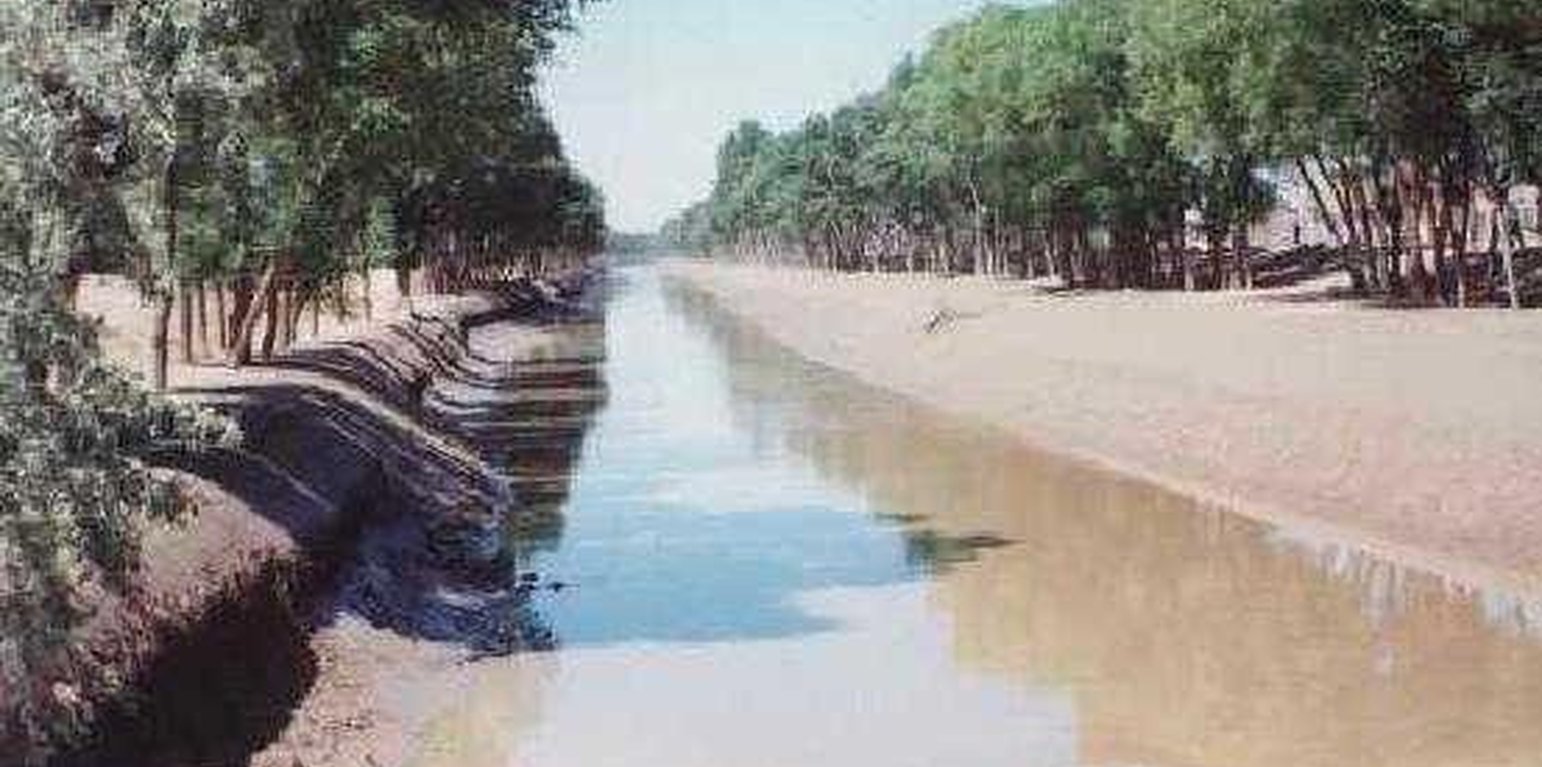Shelterbelts for farmland in sandy areas
(Хятад)
Farmland shelter belt
Тодорхойлолт
Belts of trees, planted in a rectangular grid pattern or in strips within, and on the periphery of, farmland to act as windbreaks.
Shelterbelts to protect cropland are a specific type of agroforestry system comprising certain tall growing tree species. Such shelterbelts around farmland help reduce natural hazards including sandstorms, wind erosion, shifting sand, droughts and frost. They also improve the microclimate (reduced temperature, wind speed, soil water loss and excessive wind-induced transpiration) and create more favourable conditions for crop production. Thus the establishment of shelterbelts plays a crucial role in the sandy drylands that are affected by wind and resultant desertification
especially during winter and spring. Where there is irrigation, the shelterbelts protect the infrastructure from silting-up with wind-borne sediment.
Strips of tall growing species (15-25 m) of poplar (Populus spp.) or willow (Salix spp.) were originally (from 1960s onwards) planted in a 400 by 600 m rectangular grid pattern within extensive areas of cropland, with an extra belt of windbreaks on the windward side (against the prevailing wind). Generally, the distance effectively protected is 15-25 times the tree height. Strips are of variable width, consisting of 2-5 tree lines (1-3 m apart) with trees planted every 1-2 m within the lines. Selective felling is used to maintain adequate growing space and the protective effect of the trees.
The impact of the shelterbelts depends on the planting pattern of the trees (the format of strips and grids), the orientation of the shelterbelts in relation to the wind, the spacing between, and the width of each strip and the type of trees planted. The specific design is primarily based on preventing the negative effects of wind, but depends also on local conditions such as the layout of the land, the location of the roads, farm boundaries and irrigation canals. Ideally the tree strips are perpendicular to the prevailing wind direction, and the angle between the strip and the prevailing wind is never less than 45 degrees. The structure of the strips determines the way the wind is controlled, ranging from blocking the wind
to letting it diffuse through semi-permeable shelterbelts. The best effect is achieved if the wind is not blocked entirely, as this can cause turbulence.
The ownership of the land and the shelterbelts still rests with the state, but management has been more and more transferred to individual households. On condition that the impact of the shelterbelt is not affected, the local forestry agencies now allow some felling of mature trees - on a rotational and selective basis, for timber and firewood. Pine trees (Pinus sylvestris var. mongolica and P. tabulaeformis), which command high value as timber for construction, and fruit (and cash) trees like the apricot tree (Prunus armeniace) are increasingly used.
Байршил
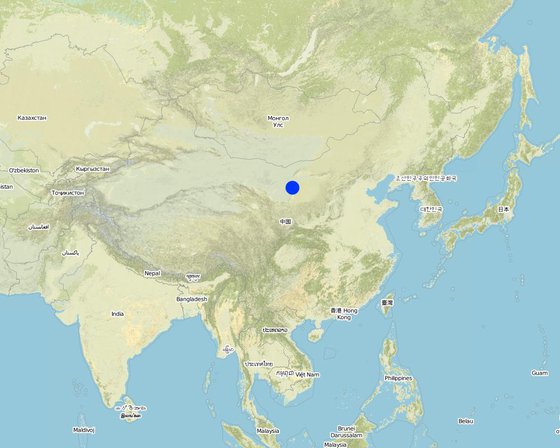
Байршил: Inner Mongolia Autonomous Region, Хятад
Дүн шинжилгээнд хамрагдсан технологи нэвтрүүлсэн газрын тоо:
Сонгосон байршлуудын газарзүйн холболт
Технологийн тархалт: газар дээр жигд тархсан (500.0 km²)
Тусгай хамгаалалттай газар нутагт?:
Хэрэгжилтийн огноо: >50 жилийн өмнө (уламжлалт)
Нутагшууллын төрөл
-
Газар ашиглагчдын санаачилгаар
-
Уламжлалт системийн хэсэг (> 50 жил)
-
Туршилт/судалгааны үр дүн
-
Гадны төсөл/хөтөлбөрийн дэмжлэгтэйгээр
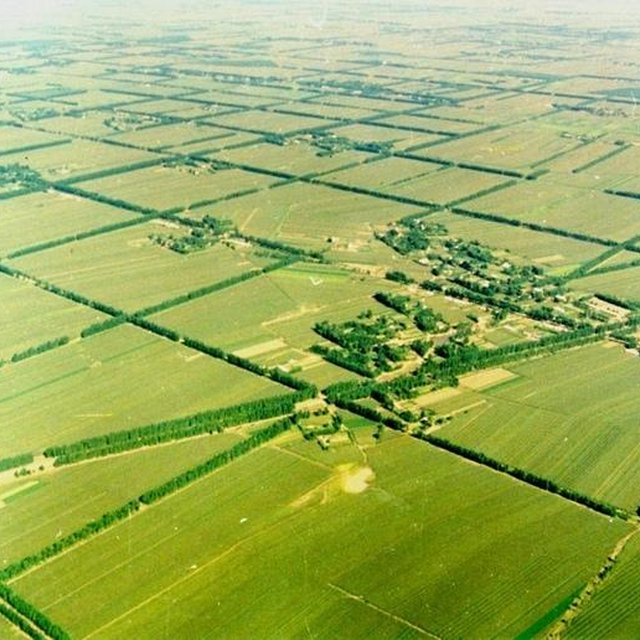
Bird’s-eye view of the rectangular grid of shelterbelts established over wide expanses of cropland to reduce natural hazards and protect crops. (Lingqin Meng)
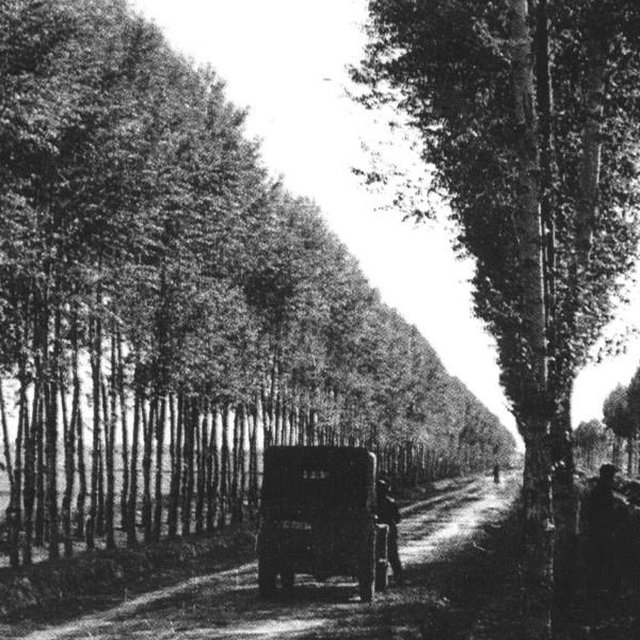
Detailed view of a shelterbelt established in the early 1960s. A road and an irrigation channel run between the tree rows. (anonymous)
Үндсэн зорилго
-
үйлдвэрлэлийг сайжруулах
-
газрын доройтлыг бууруулах, сэргийлэх, нөхөн сэргээх
-
экосистемийг хамгаалах
-
сав газрыг хамгаалах (усны эх/ голын адаг) - бусад технологитой хослуулах
-
биологийн төрөл зүйлийг хамгаалах / сайжруулах
-
гамшгийн эрсдлийг бууруулах
-
уур амьсгалын өөрчлөлт/ экстрим байдал болон түүний нөлөөлөлд дасан зохицох
-
уур амьсгалын өөрчлөлт, түүний үр нөлөөг багасгах
-
үр ашигтай эдийн засгийн нөлөөг бий болгох
-
нийгэмд үзүүлэх үр нөлөөг бий болгох
Газар ашиглалт
Нэг газр нутгийн хэмжээнд хэрэгжих холимог газар ашиглалт: Тийм - ХАА-н ойжуулалт
-
Тариалангийн талбай
- Нэг наст үр тариа: үр тариа - эрдэнэ шиш, wheat
Жилд ургамал ургах улирлын тоо: 1
-
Байгалийн ой / модтой газар
- (Таримал) байгалийн ой/мод бүхий газар. Менежмент: Сонгомол огтлол
- Мод тарьсан, шинээр ойжуулсан
Tree types: Нарсны төрөл, зүйл, Улиасны төрөл зүйл, Salix spp
Бүтээгдэхүүн ба үйлчилгээ: Мод бэлтгэл, Түлшний мод, Жимс, самар, Байгалийн гамшигаас сэргийлэх
Усан хангамж
-
Байгалийн усалгаатай
-
Байгалийн/усалгаатай арга хосолсон
-
бүрэн усалгаатай
Газрын доройтолтой холбоотой зорилго
-
газрын доройтлоос урьдчилан сэргийлэх
-
Газрын доройтлыг бууруулах
-
Хүчтэй доройтсон газрыг нөхөн сэргээх/ сайжруулах
-
газрын доройтолд дасан зохицох
-
холбогдолгүй
Доройтолын төрөл
-
хөрс салхиар эвдрэх - Et: Хөрсний гадаргын зөөгдөл, Eo: Салхины элэгдлийн дам нөлөө
-
усны доройтол - Ha: Хуурайшилт
ГТМ бүлэг
-
ХАА-н ойжуулалт
-
Салхины хамгаалалтын ойн зурвас
ГТМ арга хэмжээ
-
Ургамлын арга хэмжээ - V1: Мод ба бут, сөөг
-
Менежментийн арга хэмжээ - М1: Газар ашиглалтын хэлбэрийг өөрчлөх
Техникийн зураг
Техникийн үзүүлэлтүүд
Overview of the shelterbelt layout.
Insert 1: Planting scheme: shelterbelts compromise 2-5 tree lines forming the windbreak about 5-15 m wide and 15-25 m high.
Insert 2: Rectangle grid layout of shelterbelts. Spacing of the rows is denser against the prevailing wind.
Technical knowledge required for field staff / advisors: moderate
Technical knowledge required for land users: low
Main technical functions: increase / maintain water stored in soil, reduction in wind speed, protection from wind erosion, protection from sand encroachment, protection of crops from mechanical damage, reduction in evaporation loss
Secondary technical functions: increase in organic matter
Aligned: -against wind
Vegetative material: T : trees / shrubs
Trees/ shrubs species: Poplars (Populus spp.), willows (Salix spp.), increasingly also pine (Pinus sylvestris var. Mongolic)
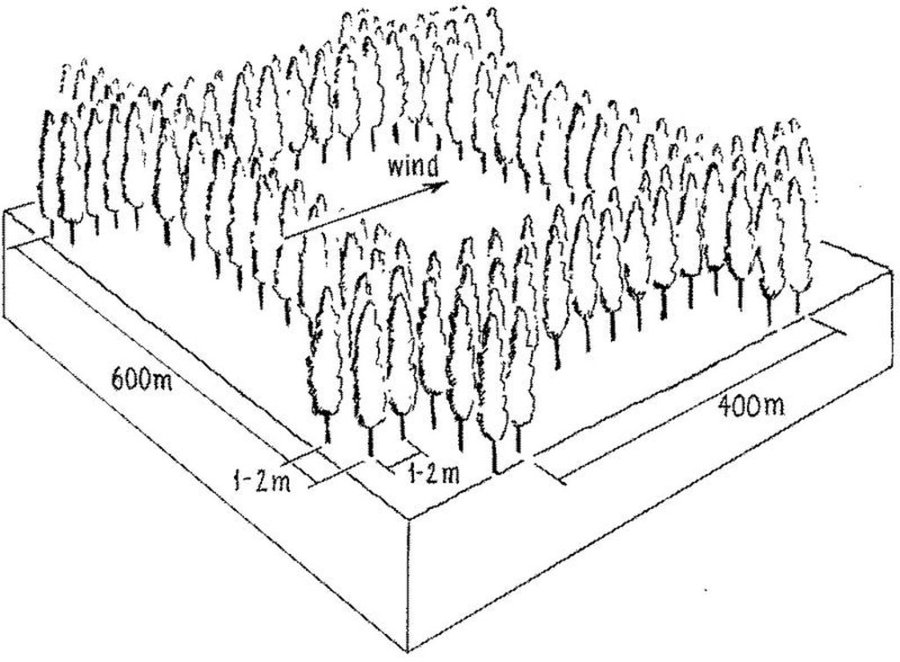
Author: Mats Gurtner
Бий болгох ба арчилах: үйл ажиллагаа, материал ба зардал
Материал, зардлын тооцоо
- Тооцоолсон зардлууд: Технологийн нэгж тус бүр (хэмжээ ба талбайн нэгж: ha)
- Зардал тооцоход ашигласан валют: Ам.доллар
- Валютын ханш (ам.дол): 1 ам.дол = тодорхойгүй
- Нэг өдрийн ажилчны хөдөлмөр хөлсний дундаж: 1.20
Зардалд нөлөөлөх хамгийн чухал хүчин зүйлс
The most important factors to affect the costs are seedlings (No.) and machine.
Хэрэгжүүлж эхлэхэд шаардлагатай үйл ажиллагаа
-
1 Planning / designing of shelterbelt. (Хугацаа / давтамж: None)
-
2 Selection and collection of trees seedlings. (Хугацаа / давтамж: None)
-
3 Clearing and preparing land for planting of shelterbelt in (Хугацаа / давтамж: late autumn and spring)
-
3 Clearing and preparing land for planting of shelterbelt in (Хугацаа / давтамж: None)
-
4 Pits for planting the seedlings are dug (Хугацаа / давтамж: 4 Pits for planting the seedlings are dug)
-
5 Tree seedlings are planted (Хугацаа / давтамж: late spring)
-
6 After planting each seedling is watered for up to two years. (Хугацаа / давтамж: None)
Бий болгоход шаардагдах материал ба зардал (per ha)
| Зардлын нэр, төрөл |
Хэмжих нэгж |
Тоо хэмжээ |
Нэгжийн үнэ (Ам.доллар) |
Зардал бүрийн нийт өртөг (Ам.доллар) |
Нийт дүнгээс газар ашиглагчийн төлсөн % |
|
Хөдөлмөр эрхлэлт
|
| Mainly collection and planting |
ha |
79.0 |
1.2 |
94.8 |
|
|
Тоног төхөөрөмж
|
| tools |
ha |
1.0 |
5.0 |
5.0 |
100.0 |
|
таримал материал
|
| tree seedlings |
ha |
1.0 |
25.0 |
25.0 |
|
| Технологи бий болгох нийт үнэ өртөг |
124.8 |
|
| Технологи бий болгох нийт үнэ өртөг, ам.доллар |
124.8 |
|
Арчилгаа, урсгал үйл ажиллагаа
-
Watering (Хугацаа / давтамж: after planting /timely)
-
Pruning of trees. (Хугацаа / давтамж: None)
-
Pest and disease control within shelterbelt. (Хугацаа / давтамж: None)
-
Intermediate/ selective tree felling. (Хугацаа / давтамж: None)
Арчилгаа, урсгал үйл ажиллагаанд шаардагдах материал ба зардал (per ha)
| Зардлын нэр, төрөл |
Хэмжих нэгж |
Тоо хэмжээ |
Нэгжийн үнэ (Ам.доллар) |
Зардал бүрийн нийт өртөг (Ам.доллар) |
Нийт дүнгээс газар ашиглагчийн төлсөн % |
|
Хөдөлмөр эрхлэлт
|
| Watering and Pruning |
ha |
7.0 |
1.2 |
8.4 |
100.0 |
|
таримал материал
|
| tree seedling |
ha |
1.0 |
3.0 |
3.0 |
100.0 |
| Технологийн арчилгаа/урсгал үйл ажиллагаанд шаардагдах нийт үнэ өртөг |
11.4 |
|
| Технологи арчилах ба урсгал ажлын нийт үнэ өртөг, ам.доллар |
11.4 |
|
Байгалийн нөхцөл
Жилийн дундаж хур тундас
-
< 250 мм
-
251-500 мм
-
501-750 мм
-
751-1,000 мм
-
1,001-1,500 мм
-
1,501-2,000 мм
-
2,001-3,000 мм
-
3,001-4,000 мм
-
> 4,000 мм
Агро-уур амьсгалын бүс
-
чийглэг
-
чийглэг
-
хагас хуурай
-
хуурай
Уур амьсгалын үзүүлэлтүүд
Жилийн нийлбэр хур тундас мм: 430.0
Налуу
-
хавтгай (0-2 %)
-
бага зэрэг налуу (3-5 %)
-
дунд зэрэг налуу (6-10 % )
-
хэвгий (11-15 %)
-
налуу (16-30 %)
-
их налуу (31-60 % )
-
эгц налуу (>60 %)
Гадаргын хэлбэр
-
тэгш өндөрлөг / тал
-
нуруу
-
уулын энгэр
-
дов толгод
-
бэл
-
хөндий
Далайн түвшнөөс дээшхи өндөр
-
0-100 д.т.д. м.
-
101-500 д.т.д. м.
-
501-1,000 д.т.д м.
-
1,001-1,500 д.т.д м.
-
1,501-2,000 д.т.д м.
-
2,001-2,500 д.т.д. м.
-
2,501-3,000 д.т.д. м.
-
3,001-4,000 д.т.д м.
-
> 4,000 д.т.д. м.
Технологийг нэвтрүүлсэн
-
гүдгэр нөхцөл
-
хотгор нөхцөл
-
хамааралгүй
Хөрсний зузаан
-
маш нимгэн (0-20 см)
-
нимгэн (21-50 см)
-
дунд зэрэг зузаан (51-80 см)
-
зузаан (81-120 cм)
-
маш зузаан (>120 cм)
Хөрсний бүтэц (өнгөн хөрс)
-
бүдүүн/ хөнгөн (элсэрхэг)
-
дундаж (элсэнцэр, шавранцар)
-
нарийн /хүнд (шаварлаг)
Хөрсний бүтэц (гадаргаас доош > 20 см)
-
бүдүүн/ хөнгөн (элсэрхэг)
-
дундаж (элсэнцэр, шавранцар)
-
нарийн /хүнд (шаварлаг)
Өнгөн хөрсний ялзмагийн хэмжээ
-
их (>3 %)
-
дунд (1-3 % )
-
бага (<1 % )
Гүний усны түвшин
-
гадаргаас
-
< 5 м
-
5-50 м
-
> 50 м
Гадаргын усны хүртээмж
-
хангалттай
-
сайн
-
дунд зэрэг
-
хангалтгүй/ байхгүй
Усны чанар (боловсруулаагүй)
-
сайн чанарын ундны ус
-
муу чанарын ундны ус (цэвэршүүлэх шаардлагатай)
-
зөвхөн газар тариалангийн зориулалтаар ашиглах (усалгаа)
-
ашиглах боломжгүй
Усны давсжилтын түвшинийг орчны асуудал гэж тооцдог уу?
Үерийн давтамж
Амьдрах орчны олон янз байдал
Технологи нэвтрүүлсэн газар ашиглагчдын тодорхойлолт
Зах зээлийн чиг хандлага
-
амь зуух арга хэлбэрийн (өөрийгөө хангах)
-
холимог (амьжиргаа ба худалдаанд)
-
худалдаа наймааны/ зах зээлийн
Орлогын бусад эх үүсвэр
-
Нийт орлогын 10 %-иас доош
-
Нийт орлогын 10-50 %
-
Нийт орлогын 50 %-иас дээш
Чинээлэг байдлын түвшин
-
нэн ядуу
-
ядуу
-
дундаж
-
чинээлэг
-
маш чинээлэг
Механикжуулалтын түвшин
-
гар ажил
-
ердийн хөсөг
-
механикжсан / мотортой
Суурин эсвэл нүүдлийн
-
Суурьшмал
-
Хагас-нүүдэлийн
-
Нүүдэлийн
Хувь хүн эсвэл бүлгүүд
-
Хувь хүн / өрх
-
бүлэг / олон нийтийн
-
хоршоо
-
ажилтан (компани, засгийн газар)
Нас
-
хүүхэд
-
залуус
-
дунд нас
-
ахимаг нас
Өрхийн зориулалтаар ашиглах газрын талбай
-
< 0.5 га
-
0.5-1 га
-
1-2 га
-
2-5 га
-
5-15 га
-
15-50 га
-
50-100 га
-
100-500 га
-
500-1,000 га
-
1,000-10,000 га
-
> 10,000 га
Хэмжээ
-
бага-хэмжээний
-
дунд-хэмжээний
-
том-хэмжээний
Газар өмчлөл
-
төрийн
-
компани
-
нэгдлийн/ тосгон
-
бүлэг
-
хувь хүн, өмчийн гэрчилгээгүй
-
хувь хүн, өмчийн гэрчилгээтэй
-
communal/state
Газар ашиглах эрх
-
нээлттэй хүртэх (зохион байгуулалтгүй)
-
нэгдлийн хэлбэрээр (зохион байгуулалттай)
-
түрээсийн хэлбэрээр
-
хувь хүн
-
individual (see Annex T3 for remark)
Ус ашиглах эрх
-
нээлттэй хүртэх (зохион байгуулалтгүй)
-
нэгдлийн хэлбэрээр (зохион байгуулалттай)
-
түрээсийн хэлбэрээр
-
хувь хүн
-
individual (see Annex T3 for remark)
Дэд бүтэц, үйлчилгээний хүртээмж
Нөлөө
Нийгэм-эдийн засгийн үр нөлөө
бүтээмжит талбай (ашиглалт/тарилт хийгдэх талбай)
off-farm income
extra timber and firewood
Crop production
Trees in competition with crops for solar radiation, fertilizer, and water
Нийгэм-соёлын үр нөлөө
Loss of Food per agricultural land
shelterbelts of trees are not a direct source of food
Экологийн үр нөлөө
гадаргын урсац
ГТМ хэрэгжихээс өмнөх тоо хэмжээ: 8
ГТМ хэрэгжиснээс хойшхи тоо хэмжээ: 0
хөрс алдагдах
ГТМ хэрэгжихээс өмнөх тоо хэмжээ: 4
ГТМ хэрэгжиснээс хойшхи тоо хэмжээ: 2
microclimate for crops
regulating temperature, increasing humidity
conservation/maintenance of soil fertility
Зэргэлдээ талбайд илрэх нөлөө
Өртөг ба ашгийн шинжилгээ
Бий болгох зардалтай харьцуулахад олсон ашиг
Урсгал зардалтай харьцуулахад олсон ашиг
Богино хугацаанд эргэн төлөгдөх байдал
Урт хугацаанд эргэн төлөгдөх байдал
Нутагшуулах ба дасан зохицох
Тухайн нутаг дэвсгэрт Технологийг нэвтрүүлсэн газар ашиглагчдын хувь
-
жишээ/ туршилт
-
1-10 %
-
11-50%
-
> 50%
Технологийг нэвтрүүлсэн бүх хүмүүсийн хэд нь материаллаг урамшуулал авалгүйгээр технологийг хэрэгжүүлсэн бэ?
-
0-10%
-
11-50%
-
51-90%
-
91-100%
Хамрагдсан өрх ба/эсвэл газар нутгийн хэмжээ
40 households in an area of 100-1000km^2 (10-50 persons/km^2)
Технологи нь өөрчлөгдөж буй нөхцөл байдалд дасан зохицохын тулд өөрчлөгдсөн үү?
Ямар өөрчлөлтөнд эмзэг вэ?
-
уур амьсгалын өөрчлөлт/ экстрим үзэгдэл
-
зах зээлийн өөрчлөлт
-
ажил хөдөлмөр эрхлэх боломж (ж.нь шилжих хөдөлгөөний улмаас)
Дүгнэлт, сургамж
Давуу тал: газар ашиглагчийн бодлоор
Давуу тал: эмхэтгэгч эсвэл бусад мэдээлэл өгсөн хүмүүсийн бодлоор
-
Reduced wind speed and trapped wind-blown sand particle
How can they be sustained / enhanced? Combine deciduous and evergreen trees to maintain shelterbelt’s protective function throughtout the year.
-
Increased crop yield
How can they be sustained / enhanced? Extend shelterbelt technology to unprotected croplands.
-
Increased cash income
How can they be sustained / enhanced? Improve rotational felling regimes that maximise quantity and quality of tree products (timber; fruit etc) without reducing the shelterbelt’s protective function. In Inner Mongolia apricot (Prunus armeniaca) and sea buckthorn (Hippophae rhamnoides) and in Gansu Province the Chinese dates (Ziziphus jujuba) are increasingly used.
-
Apart from their effect on the wind, the overall benefits of the shelterbelts - for timber, firewood, fruits and fodder for animals - outweigh the loss of cropland occupied by trees
How can they be sustained / enhanced? Experience over 40 years has demonstrated that narrower trees strips and smaller grid size (100 by 200 m) would increase ecological efficiency, but due to higher costs and potential competition with crops, the spacing of the shelterbelts has mostly remained as it was originally.
-
From 1960 onwards, approximately 22 million hectares – of vulnerable cropland have been protected in eastern Inner Mongolia
Editors’ comments: In China, a total of 1.84 million km2 suffer from desertification related to sand storms, shifting sands and wind erosion, making up 19% of the total land area. In those dry and desertified zones, farmland is barely productive, even with irrigation. The construction of shelterbelts in this northeastern part of China has had multiple benefits that outweigh the loss of cropland. However, maintenance has become an important issue with the changes in China’s land use laws. This is one of two examples of windbreaks amongst the case studies in this book. Remark: In the 1960s, all land ownership and land use rights in China were communal and cropland was farmed collectively by village communes. After reform and open policy was put into practice in 1978, land use rights were transferred to the villages, to groups and individuals. Land itself and the shelterbelts however still belonged to the state. Nowadays the rights to cultivate specific parcels of land, within protected blocks, are generally granted to individual farm households. In some cases, in recent years, the shelterbelts too have been redistributed to individuals to look after. Inevitably maintenance has become an issue. But most of the shelterbelts are managed well. 3.2.8: If farmer cuts mature timber (for example a 40 year-old poplar), he/she can sell it for US$ 20–25 per tree. With maturity of shelterbelts, the timber production increases, which brings increasing economic benefits; meanwhile, the effect of protection from wind erosion also improves.
Сул тал/ дутагдал / эрсдэл: газар ашиглагчийн бодлоордаван туулах боломжууд
Сул тал/ дутагдал / эрсдэл: эмхэтгэгч эсвэл бусад мэдээлэл өгсөн хүмүүсийн бодлоордаван туулах боломжууд
-
Loss of land due to area used for the shelterbelts
In this wind-prone part of Inner Mongolia, overall gains from the protected zones compensate for the reduced area under crops, especially if economically valuable species are planted in the shelterbelt, such as Caragana korshinskii, which can be used as forage, for 'green fertilizer' through leaf mulch and for firewood.
-
Competition for sunshine, fertilizer and water
Pruning of branches and digging of ditches to prevent roots penetrating the adjacent cropland
-
Farmers lost the right to crop the tree-occupied land (since the shelterbelts belonged to the state). Originally, farmers were not allowed to fell trees
Nowadays the local forestry department permits farmers to occasionally cut trees, which is a source of income. If land users were allowed to cut trees on a more systematic basis, it would help them to better appreciate the benefits.
-
High cost (labour and money) for establishment
Government support required.
-
Shelterbelts comprised of single tree species are less resistant to pests and diseases
Shelterbelts consume more water
Combine trees and shrubs/ different species, which improves both resistance and also the protective effect.
But they also help in drainage (where this is a problem) through lowering the ground water table and simultaneously reducing salinity. Appropriate tree species need to be selected and bred.
Суурь мэдээлэлүүд
Хянагч
-
David Streiff
-
Deborah Niggli
-
Alexandra Gavilano
Баримтжуулсан огноо: 15 12-р сар 2010
Сүүлийн шинэчлэл: 13 3-р сар 2019
Мэдээлэл өгсөн хүн
-
Yaolin Wang - ГТМ мэргэжилтэн
-
Dogmei Wang - ГТМ мэргэжилтэн
WOCAT мэдээллийн сан дахь бүрэн тодорхойлолт
Баримтжуулалтыг зохион байгуулсан
Байгууллага
- GEF/OP12 Gansu Project (GEF/OP12 Gansu Project) - Хятад
Төсөл
- Book project: where the land is greener - Case Studies and Analysis of Soil and Water Conservation Initiatives Worldwide (where the land is greener)
Гол сурвалж баримт сэлт
-
China atlas. China atlas publishing house, P 52.. 1999.: library of Department of Resource and Environmental Science, BNU.
-
Zhao Yu, Jing Zhengping, Shi Peijun, Hao Yunchong et al. Inner Mongolia soil erosion research remote sensing was used in Inner Mongolia soil erosion research, Science publishing house, P25.. 1989.: library of Department of Resource and Environmental Science, BNU.
-
Inner Mongolia forest department, Forest work manual,12, P33-34, P67.. 1998.: library of Department of Resource and Environmental Science, BNU.
-
Synthesized investigate team in Inner Mongolia-Ningxia, CAS. West of northeast Forest in Inner Mongolia autonomy region, Science publishing house, P82-101.. 1981.: library of Department of Resource and Environmental Science, BNU.
-
Sun Jinzhu. Natural condition and reconstruct in Hetao plain, Inner Mongolia people' s publishing house, P188-189.. 1976.: library of Department of Resource and Environmental Science, BNU.
-
Inner Mongolia forest Department. Inner Mongolia autonomy region forest statistic data,P75.. 1987.: library of Department of Resource and Environmental Science, BNU.
-
Hu Chun(chief editor). Inner Mongolia autonomy region climate resources about agriculture, forest and animal husbandry, Inner Mongolia people's publishing house, P45-47.. 1984.: library of Department of Resource and Environmental Science, BNU.
-
Water and soil conservation bureau, Yellow River irrigation works committee of Department of water and electricity. Water and soil conservation economy benefit thesis collecting, P45-47.. 1987.: library of Department of Resource and Environmental Science, BNU.
-
Zhang Pangchuen, A study on the benefit of shelter belt in the south part of Kerqin sand to agriculture increase in production. Journal of arid land resource and environment. Vol.4, no.1, P11-87.. 1990.: library of Department of Resource and Environmental Science, BNU.
-
Sun Jinzhu,Chen Shan(chief editor). Inner Mongolia environment alarm beforehand and repair countermeasure. Inner Mongolia people's publishing house, P132.. 1994.: library of Department of Resource and Environmental Science, BNU.
-
Compilation Committee of Inner Mongolia Forest Inner Mongolia Forest, Beijing: China Forestry Publishing House, 1989,299–319. 1989.:
